cosmic ray propagation
Solar Wind, Heliosphere, and Cosmic Ray Propagation
Before reaching the Earth, cosmic rays travel through a complex interstellar and interplanetary medium. The number of cosmic rays received per second at Earth (i.e. their flux) and other properties are affected by the magnetic fields encountered by the particles. The variable magnetic field of the Sun, dragged out by the solar wind, disturbs the propagation of cosmic rays during their propagation through the Heliosphere, and introduces variations on time scales that range from hours to millennia.
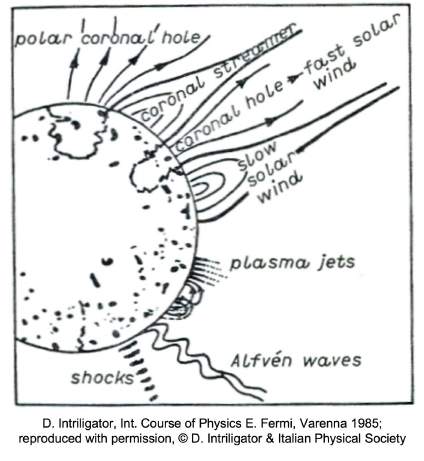
The solar corona and the Heliosphere
We know from eclipse photographs (and from coronagraphic observations - e.g. the LASCO experiment on SoHO, ESA/NASA) that the Sun extends well beyond the bright region that we usually see, called the photosphere. The solar corona is a tenuous magnetised gas, with an average temperature of about (1-2) x 106 K. It is almost totally ionised, and composed of electrically charged particles. Such an ionised gas is called a plasma. Gravity alone cannot retain it at the Sun. It was realised in the 1950s, both from observations and from physical considerations, that this plasma must be supersonically expanding away from the Sun, and pervade the entire solar system.
The solar wind is the hot plasma that expands in all directions from the solar corona with speeds ranging from slightly below 300 up to more than 1000 km/s during transient events. Two regimes can be distinguished in the regular solar wind: the fast solar wind emanating from coronal holes at a speed up to 800 km/s, and the slow solar wind from other regions in the corona (especially the large structures called coronal streamers, well known from eclipse photographs) with speed up to 400 km/s. Like the corona the solar wind consists mainly of charged particles: protons, electrons, and a small addition (5%) of ionised helium and few ions of heavier elements. The schematic drawing shows some features that can be seen in coronagraphic or eclipse images: large-scale streamers, which contribute to the slow solar wind, and coronal holes, from where the fast wind emanates. The corona is also a dynamical medium on smaller scales, with plasma jets, shocks and magnetic field perturbations called Alfvén waves. These structures and disturbances shape the interplanetary medium, and contribute to its dynamics.
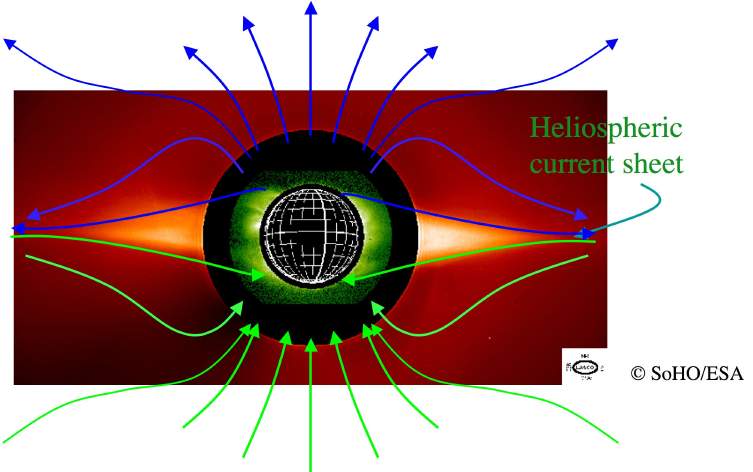
The solar wind carries the Sun's magnetic field into the solar system. While close to the Sun the magnetic field is strong enough to retain the plasma and to shape the corona, at some distance above the surface the hot plasma dominates the magnetic field, and drags magnetic field lines out. The schematic drawing, overlaid on a SoHO image of the corona in 1996, shows field lines which, starting at some distance, align with the solar wind flow, which is here assumed to be simply radial. The equatorial plane separates magnetic field lines of opposite orientation. This sudden change of the magnetic field implies an electric current. The narrow layer between the oppositely oriented magnetic fields is called the heliospheric current sheet. In reality it is not a simple plane surface, because the solar corona is not symmetric.

The field lines extending into the interplanetary space remain rooted in the Sun, and rotate with it. The radial outflow of the solar wind resembles the outflow of water from a rotating sprinkler in the garden - the trajectory of water drops is curved by the rotation of the sprinkler. An observer on the Sun following a parcel of solar wind would see just the same. And the magnetic field is aligned with this trajectory. This is why magnetic field lines in the interplanetary medium are curved. When one looks on them from above the Sun's northern pole, they have the shape of an Archimedean spiral, which is also called a Parker spiral, after Eugene Parker who in 1958 developed the first hydrodynamical model of the solar wind with its embedded magnetic field. As seen in the Figure, the Parker spiral magnetic field line connects the Earth with a point to the right of the centre of the solar disk, in the Sun's western hemisphere.
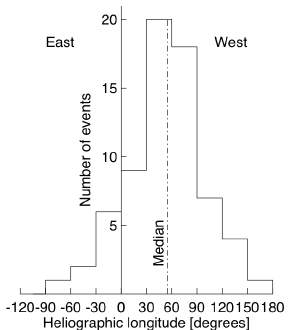
When charged particles are accelerated at the Sun and ejected at high energies into interplanetary space, they must travel along the interplanetary magnetic field. If this is described by a Parker spiral, we expect to detect energetic particles at the Earth when the acceleration occurs in the western solar hemisphere. Neutron monitor observations confirm this expectation in a statistical sense: the histogram on the right shows the distribution in longitude on the Sun (heliographic longitude) of the flares associated with the particle events. The distribution is maximum in the range 30°-60° western longitude, as expected if the energetic particles propagate along Parker spiral field lines. However, there are noticeable exceptions, such as energetic particles coming from the eastern solar hemisphere or associated with presumed flares on the far side of the Sun. The Parker spiral gives a simple model of an average magnetic field configuration, but not necessarily the true configuration in each individual event.
| Solar wind parameters measured by spacecraft near the Earth | Fast wind | Slow wind |
|---|---|---|
| Velocity | 500-800 km/s | 250-400 km/s |
| Density | 3x106 m-3 | 10x106 m-3 |
| Proton temperature | 2x104 K | 4x104 K |
| Electron temperature | 1.2x105 | 1.5x105 K |
| Magnetic field | 2-10 nT | 2-10 nT |
- Unit of the magnetic field strength: 1 nT (nano Tesla) = 10-9 Tesla
- The temperatures of protons and electrons are different, as is typical of a low-density gas (this is also the case in a neon tube)
The Heliosphere and its disturbances
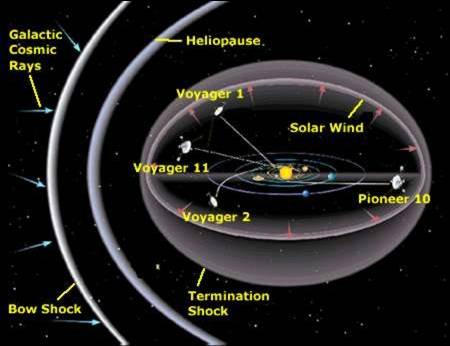
The Sun's large scale magnetic field and the Heliosphere
The Heliosphere is the three-dimensional region around the Sun that is filled by the solar wind and its embedded (frozen-in) magnetic field. The supersonic solar wind encountering the interstellar medium undergoes a transition to subsonic speed at the termination shock, while this transition should occur for interstellar wind at the heliospheric bow shock (image (dead link)).
The size of the heliosphere was estimated to about 100 AU (1 AU is the distance between the Sun and Earth=Astronomical Unit 1.5x108 km), based on neutron monitor measurements of the temporal variations of galactic cosmic ray flux (see below). It was directly observed by the two Voyager spacecraft as they crossed the heliospheric termination shock in 2007 and 2008.
Disturbances of the Heliosphere
Space probes give the chance to measure directly the solar wind fundamental physical parameters. The solar wind is not a quiet flow of gas: continuous fluctuations of the magnetic field (Alfven waves) are produced by turbulent motions of the gas at the Sun, and move outward. Discontinuities of the magnetic field and shock waves are produced by the collision of fast and slow solar wind streams (co-rotating interaction region; CIR) and by eruptions in the solar corona, coronal mass ejections (CME) and solar flares. Coronal mass ejections propagate through the solar system, and can be measured near the Earth as interplanetary coronal mass ejections (ICMEs). Some of them are called magnetic clouds. When they are fast enough, they drive a shock wave ahead of them - like an airplane that flies faster than sound in the Earth's atmosphere.
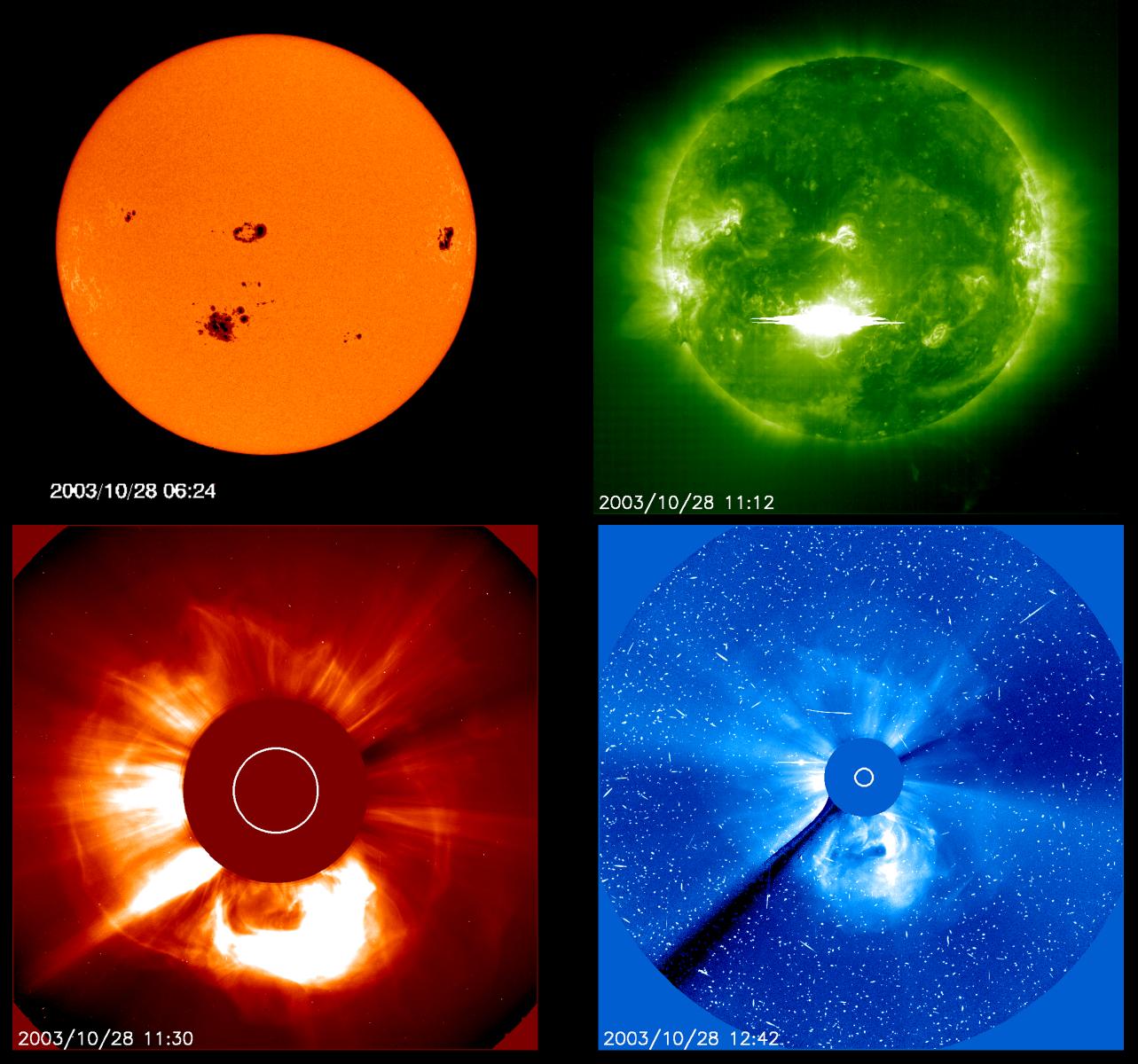
The Figure on the left shows an example of an intense solar flare and coronal mass ejection, which perturbed the Heliosphere considerably. The four snapshots of the Sun were taken by different instruments aboard the SoHO spacecraft (ESA/NASA) on 28 October 2003: groups of sunspots (top left) indicate intense activity and complex magnetic fields at the solar surface. In the largest and most complex of these regions a bright flares occurred. It was observed, for instance, by the Extreme Ultraviolet Telescope (EIT; top right figure). A fast and large coronal mass ejection was seen a few minutes later by the LASCO coronagraphs (bottom figures), which propagated through the corona at a speed exceeding 1000 km/s.
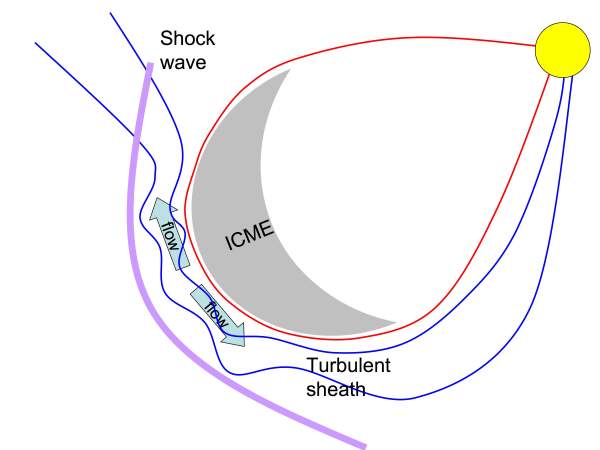
Spacecraft observations showed that this fast CME engulfed the Earth one day later, on October 29. The figure below shows a schematic drawing (after Y. Liu et al., J. Geophys. Res., 111, A09108): the expelled coronal magnetic field structure (field line in red) disturbs the heliospheric magnetic field (field lines in blue). The solar wind plasma cannot penetrate into the ICME. Therefore it is compressed, and with it the magnetic field, or diverted around the outward propagating ICME as indicated by the two blue arrows. The shape of the field lines is changed. At the interface between the ICME and the ambient solar wind the magnetic field may become turbulent. In such a perturbed Heliosphere both solar and galactic cosmic rays have quite different conditions of propagation than in the quiet heliosphere.
Cosmic ray transport in the Heliosphere
Cosmic rays penetrating into the Heliosphere interact with the solar wind. Very energetic charged particles will remain unaffected - they traverse the solar wind as if it were not there. But cosmic rays at moderate energies, say up to some tens of GeV, do feel its influence. Not through collisions, since the gas is far too dilute for direct collisions between a cosmic ray particle with a solar wind particle. But the varying magnetic field makes the trajectory of cosmic rays with moderate energies deviate strongly from a straight line.
We can understand this by using the elementary description of charged particle propagation in a uniform magnetic field. When the magnetic field varies in time, the particle encounters rapidly changing magnetic field line directions along its trajectory, and therefore has directions of propagation that change all the time. One says that the particle is scattered by the magnetic field irregularities.
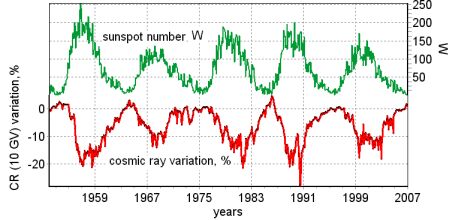
Solar modulation of galactic cosmic rays
Galactic cosmic ray particles are scattered by the magnetic irregularities propagating with the solar wind. The number of such irregularities varies with the 11-year periodicity of the solar activity. The solar activity cycle is clearly shown by the number of sunspots (green curve). Long time monitoring with the worldwide network of neutron monitors reveals that the flux of galactic cosmic rays has a similar variation (red curve): when the number of sunspots is high, the galactic cosmic ray flux is low, and vice versa.
This so-called solar modulation of galactic cosmic rays is due to the propagation of the energetic particles in the dynamical environment of the Heliosphere. The magnetic field in the Heliosphere is highly variable during periods of high activity, i.e. when the number of sunspots, but also of flares and mass ejections, is high. The turbulent interplanetary magnetic field then deviates the cosmic rays much more efficiently than in periods of low activity, when the magnetic field is more regular. The strong magnetic field fluctuations do not only reduce the number of cosmic rays reaching the inner Heliosphere and the Earth, but they also change their energy spectrum (because particles of lower energy are more strongly affected than very energetic ones) and their direction of propagation (anisotropy).
Once we have noticed the similarity between the time histories of sunspot number and the galactic cosmic ray flux, it is interesting to notice the difference: the time evolution of the cosmic ray flux at Earth is different in two successive activity cycles. In one the curve is peaked, with a clear maximum (in 1987, for instance), while it is much flatter at the following maximum (1997). This is due to the fact that the solar activity cycle is actually one of 22 year periodicity, rather than 11 years. Every 11 years the overall solar magnetic field reverses polarity, and this affects strongly the propagation of charged particles through the Heliosphere.
Besides through its activity cycle, the Sun also affects cosmic ray propagation through the location of the active regions. This creates variations with lower amplitude, typically with durations related to the 27 day solar rotation period. The long time variations of cosmic rays, up to time scales of millennia, leave imprints on the Earth, which can especially be found in probes of polar ice. We are presently witnessing a particular period of prolonged weak activity: as of May 2009 we do not know if the activity minimum is behind us or still ahead - this means that 13 years passed since the last minimum in 1996, instead of the average 11 years! The cosmic ray modulation confirms this, since their flux is presently higher than in past minima of solar activity.
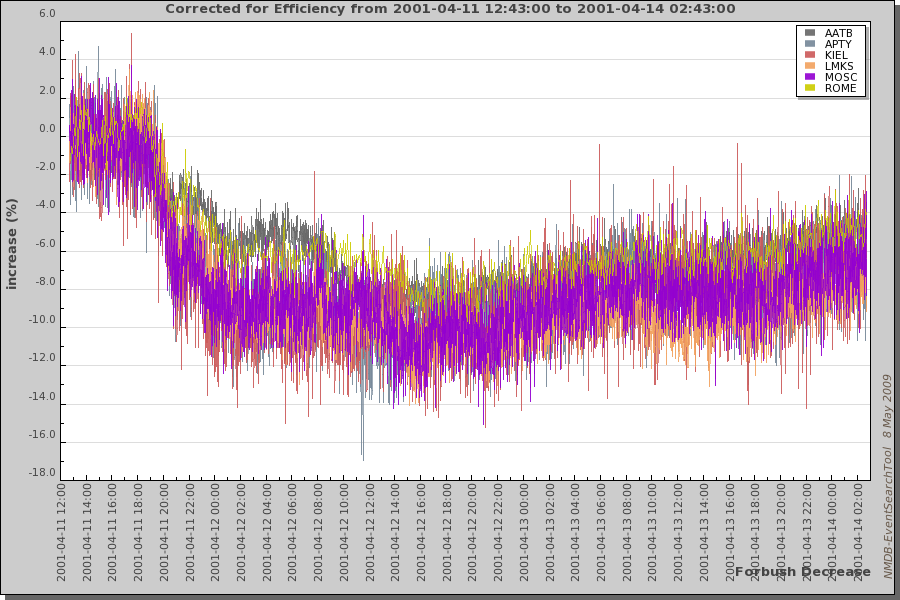
Forbush decreases
The magnetic field configurations propagating through the Heliosphere as Interplanetary Coronal Mass Ejections (ICMEs) also reduce the galactic cosmic ray flux. The Figure shows an observation in April 2001 from the NMDB data pool. The count rates before the event have been subtracted, the curves show the percentage of the count rate as compared to the average values measured before the event. The depressions can attain values of 20%. They are called Forbush decreases after the cosmic ray physicist Scott Forbush. The depressions of cosmic ray flux are ascribed to the shield produced by the complex and turbulent magnetic field structure in and around the ICME and the shock wave it drives ahead of it.
If you want to look at other Forbush decreases, go to the NMDB event search tool. Choose the number of the Forbush decrease and the station whose observations you want to plot, and press “Submit”.